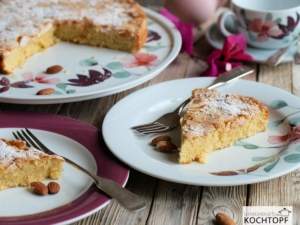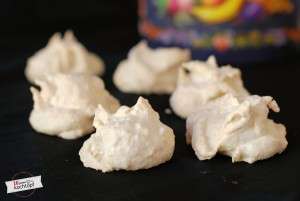My recipe for this event ended as a disaster. As I have no time to start a new trial I will present it anyway.
Elise is hosting the SHF #12 with the theme cooking up custard. As a Swiss I had no clue what custard is. On the internet I found hundred of descriptions among others this one:
Many of Spain’s desserts are egg based. Over the centuries, the Spanish monks clarified their wines with eggs and donated the egg yolks (“yemas”) to the local nuns who then used them to make desserts. The entrepreneuring nuns would then sell their desserts to the villagers. Natillas, Cuajada, Flan and Crema Catalan are all egg based Spanish custards.
As I live in Spain and never prepared a Crema catalana, I decided to do something similar. In my garden I have a lot of figs and quinces so I wanted to integrate them.
I call the recipe Trío de crema casera.
Trío de crema casera
6 small molds
1,5 dl cream, heavy
0,5 dl milk
2 tb vanille sugar
2 egg yolks
35 g brown sugar
1 fig
Combine cream, milk and vanille sugar in saucepan. Bring to boil. Remove from heat. Beat egg yolks and brown sugar in bowl until light colored. Start to pass the milk/cream mixture and slowly temper into yolk/sugar by using a spatula. A whisk will beat too much air bubbles into crema. Cut fig in slices, arrange in 2 molds. Carefully fill molds with crema. Place a larger baking pan in the oven and fill half way with water. Put custard baking dish in the water bath. Bake in oven covered with aluminum foil at 160°C for approx. 45 minutes or until the center of the crema is firm when gently shaken. Allow to cool uncovered to room temperature then place into fridge. Refrigerate at least 3 hours or overnight.
Until here everthing worked out. But then today, the disaster started:
Quinces
1 quince
1 dl apple juice
1 tb brown sugar
Core the quince and cut into slices. Combine apple juice, sugar and quince slices in saucepan. Boil during 30 minutes. Remove from heat. – Still ok!
Preheat broiler. Decorate 2 molds with slices of quinces. Sprinkle brown sugar evenly over crema. Broil until brown sugar caramelizes. (Or caramelize with round branding iron).
My broiler does not work properly. After 10 minutes I decided to take them out.
The result looks not too bad,
but as I used aluminum molds, the crema took taste of aluminum. Not very yummy! :-(
The fig does not very harmonise with the crema. The best of the trio is the crema with quinces. This one I will try again but in authentic Spanish ceramics, which I need to buy.




aber manchmal hat man eben Pech. Warum hast du nicht deine schweinchenrosa Förmchen genommen, die hätten doch auch gehen müssen oder?
REPLY:
Die schweinchenrosa Förmchen halten, so glaube ich, diese Hitze nicht aus. Am Schluss muss man’s ja cramelisieren und zu tief sind sie dazu auch. Aber ich kaufe mir ein paar echte spanische Förmchen.
REPLY:
Jetzt habe ich es kontrolliert. Die schweinchenrosa Förmchen können 280 Grad Hitze vertragen.
schweinchenrosa Förmchen nach denen muss ich mal schauen in deinem Blog, die habe ich wohl noch nicht gesehen. Meinem Finger geht es wieder gut. Habe mich auch an was porteguisches gewagt ohne zu wissen wie das Orginal schmeckt. Wenn ich die Bilder heute noch bekomme mache ich auch mit. Habe zur Zeit keine Kamera, fotografiere mit der einer Freundin, die auch sehr beschäftigt ist und dessen Karte mir nicht erlaubt gleich die Bilder auf meinen Computer runterzuladen. Ah alles zu kompliziert;)
REPLY:
für dilek gibt es hier:
http://www.kochtopf.me/stories/brioche/#923878
und hier:
http://www.kochtopf.me/stories/moccaparfait-fiorini/
Besonders der Aluminiumgeschmack. Meine Versuche mit Creme brûlée und dem Grill sind auch misslungen. Da ist nie auch nur irgendwas karamellisiert. Seit ich einen Brülierbrenner (Flammenwerfer ;-)) habe, funktionierts prima.
REPLY:
noch so ein Spielzeug. ;-) Ich glaube so ein Teil lege ich mir nicht zu, lohnt sich nicht für 1x im Jahr caramelisieren. Oder wozu kann man ihn noch gebrauchen?
Der Zucker auf den Quitten ist caramelisiert, aber das war auch der Einzige. :-(
REPLY:
Hmmm, also bei mir lohnt es sich, weil ich viel Creme brûlée mache. Andere Einsatzmöglichkeiten als Zucker anzukokeln habe ich noch nicht gefunden. Es gibt dann noch „Brülier-Eisen“. Da hält man das heiße Eisen direkt auf den Zucker auf der Creme. Davon hat mir aber mein Küchen-Höker abgeraten, weil man, wenn man Pech hat, beim Abnehmen des Eisens auch gleich die Caramelschicht mit abreißt… Frage mich, wozu es diese Eisen dann überhaupt gibt.
REPLY:
Vielleicht um Brandzeichen, oder wie die heissen, bei Kühen zu hinterlassen. ;-)
REPLY:
Meine Grossmutter hat mit so einem Eisen Griesspudding caramellisiert. Das Eisen wurde im Holzfeuer rotglühend erhitzt und draufgepappt. Es gibt wenig, was besser riecht.
Man muss einfach richtig viel Zucker nehmen, dann wird die Caramelschicht so dick, dass sie bestimmt nicht mit abreisst.
Den Flammenwerfer hingegen kann man auch bestens brauchen, um Grillkohle anzuzünden, Unkraut zu vernichten, zu löten, Wachsflecken von Steinböden zu entfernen und und und…
REPLY:
Mangels Garten werde ich mit dem Flammenwerfer wohl kaum Unkraut beseitigen. Dafür hat mein Brenner wohl auch nicht genug Power und muss mühsam mit Gasfläschen wieder neu aufgefüllt werden. Aber als Grillanzünder – das merk ich mir!
REPLY:
So, das gewünschte Foto vom Brenner gibts jetzt mit einem neuen Post:
http://www.foolforfood.de/index.php/2005/09/19/brullierbrenner_zum_karamellisieren
Well, they look delicious! Too bad about the molds. It was probably a good idea to throw them out.
… „cuajada“ is not an egg based dessert, in fact, it’s similar to yoghurt, there’s no egg at all. In ‚exchange‘ I’ll give one more egg based typical Spanish one: „leche frita“ (the name refers to milk, but in fact it’s fried solidified custard), delicious, but very difficult to make. I’ve just remembered „tocino de cielo“, a sort of „flan“ (solid custard with caramel), although it’s sweeter. And nuns being mentioned, „yemas“ (yolks) are made in many nunneries, they are sugary actual yolks (not everyone likes them) presented in small muffin paper cups . Anyway, pity the aluminium taste, but it looks better than you think. Suerte for next try!